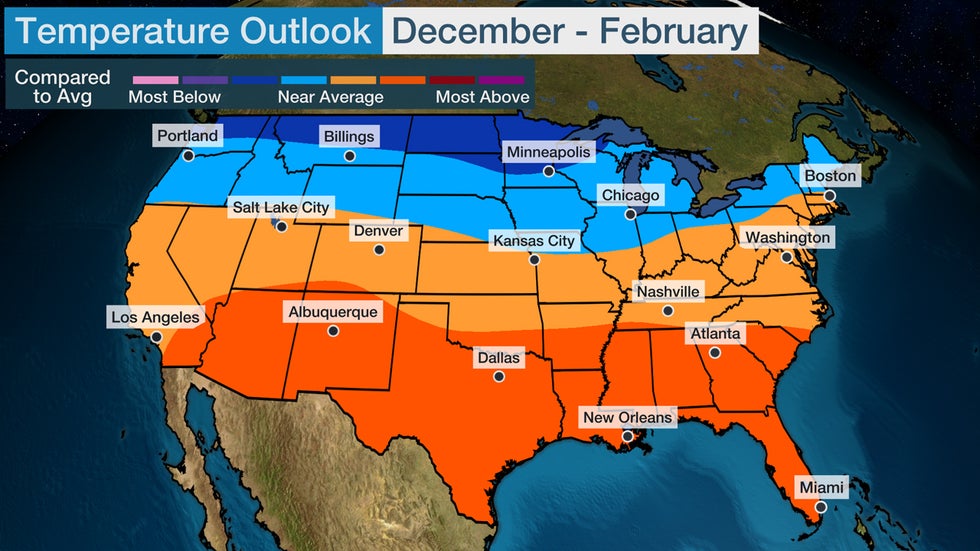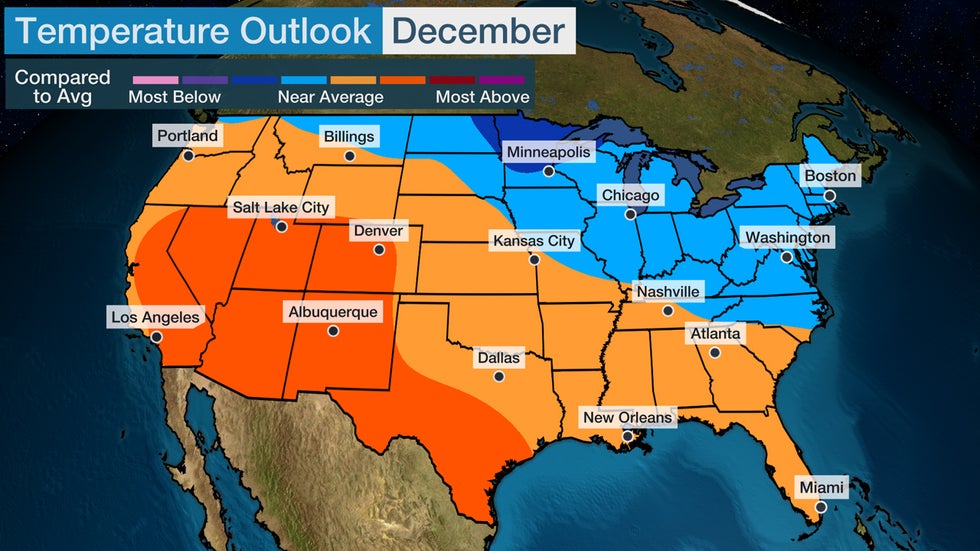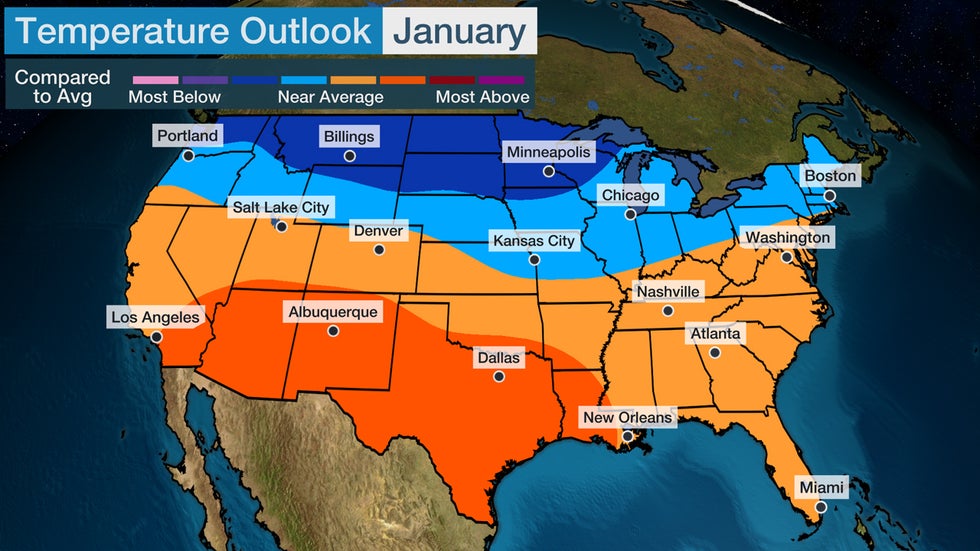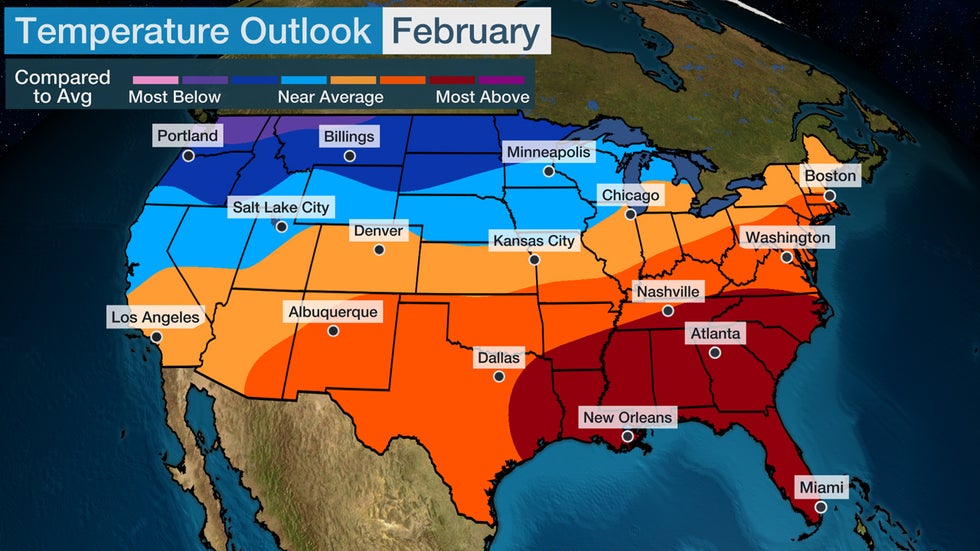weather.com meteorologists
Temperatures in an updated winter outlook have trended colder in the nation's northern tier, but that remains in stark contrast to the warmer-than-average conditions anticipated in the South.
Areas from northern New England westward to the upper Midwest and Pacific Northwest have odds tilted toward seeing below-average temperatures for the three-month winter period from December through February, according to the outlook released Friday by The Weather Company, an IBM Business, and Atmospheric G2.
In particular, the northern half of Washington to portions of Montana, North Dakota, Minnesota and northern Wisconsin are most likely to see colder-than-average temperatures.
On the opposite side of the spectrum, a broad area from the Southeast to the Southern Plains and Southwest is forecast to have the best chance of above-average temperatures during the next three months as a whole.

Keep in mind this outlook is an overall three-month trend. Therefore, we will likely see periods that are warmer or colder in each respective region of the country when compared to what is shown above.
With that in mind, let's dig into the month-by-month details and follow up with some of the factors driving this forecast.
December
In December, the outlook has trended colder in the Midwest but generally remains the same as before along the East Coast.
Meanwhile, the Southwest and much of the Rockies are most likely to see December end up warmer than usual. However, the extremity of the expected warmth when compared to average has decreased from earlier projections in the interior West, namely from southern Montana into much of Utah, Colorado, Arizona and New Mexico.

January
The dramatic contrast between a colder-than-average northern tier and above-average temperatures in the South begins to sharpen as we head into the New Year.
Overall, the forecast for January has trended colder from Washington eastward to portions of Montana, the Dakotas, much of Minnesota, northern Wisconsin and the Upper Peninsula of Michigan.
The area most favored for warmer-than-average temperatures has shrunk, but still includes parts of the Southwest into the Southern Plains.

February
Winter's final full month is expected to have the most pronounced north-to-south temperature contrast.
Much of the Southeast could be thinking an early start to spring is on the horizon since far-above-average temperatures are favored in that region.
Meanwhile, locations from the Northwest to the Northern Plains will have to keep winter coats handy given the increased likelihood of colder-than-average conditions.

Winter Outlook Q And A
What's driving the forecast?
La Niña - the periodic cooling of the equatorial Pacific Ocean waters - is in play as one of the drivers for the winter outlook once again this year.
"We continue the remarkable drive toward a third consecutive La Niña winter, a relatively rare occurrence in our recorded history, with the last three-peat occurring from 1998-2000," said Dr. Todd Crawford, Vice President of Meteorology at Atmospheric G2.
The cooling of these waters can have an atmospheric domino effect that influences weather patterns across the globe.
In the U.S., La Niña typically means a colder-than-average winter in northern and western parts of the country, and a warmer South and East.
But there's a potential curveball with La Niña this winter. The atmosphere's response, which ultimately matters for our weather patterns, might be weaker than what's typically expected in a La Niña winter. Therefore, other factors in the atmosphere might override La Niña's influence and lead to a larger number of weather pattern changes for weeks at a time.
There are other puzzle pieces besides La Niña to consider in the forecast, which leads us to the next question.
What's the role of the polar vortex and NAO?
Whether the polar vortex stays strong or weakens at some point in winter can definitely impact the forecast. However, this ingredient in the forecast cannot be predicted until winter is in progress.
In winter 2020-21, the polar vortex weakened, and even though La Niña was in place, a major cold outbreak contributed to the 19th-coldest February on record in the Lower 48. The impacts from the cold plunge resulted in a multi-billion-dollar disaster, with Texas especially hard-hit.
Crawford said there is less than a 50% chance of a sudden stratospheric warming (SSW) event this winter. This warming of the stratosphere in the Arctic region is what typically creates the domino effect that weakens the polar vortex.
Since an SSW is unlikely, it implies the polar vortex will remain stronger this winter, keeping colder air more bottled up in northern latitudes like last winter.
The one wild card to this expectation is the NAO, or the Northern Atlantic Oscillation.
There are some indications the NAO could skew into its so-called negative phase at times this winter, which would allow colder air to spill into the South and Northeast.
That's because blocking high pressure exists near Greenland when the NAO is in its negative phase, which forces cold air to lock in across the eastern states through a southward plunge of the jet stream.
Once again, this is a factor that can't be predicted with confidence very far in advance, so we'll be monitoring it all winter.
 Colder air and blocking weather pattern often develop when the polar vortex is weak.
Colder air and blocking weather pattern often develop when the polar vortex is weak.Will the huge Tongan volcano eruption last January have a role?
While it's true that large volcanic eruptions have historically had a temporary cooling effect on Earth's climate, that's not the case for the Tongan eruption.
"The eruption of (the volcano) back in January will likely not cool the climate, given it was an underwater volcano that ejected water vapor, rather than particulates, into the stratosphere; On the contrary, given water vapor is a greenhouse gas, it may have a warming impact on the climate over the next few years," Crawford explained.
The bottom line, according to Crawford, is this eruption isn't expected to be a significant influence on this winter's weather.
The Weather Company’s primary journalistic mission is to report on breaking weather news, the environment and the importance of science to our lives. This story does not necessarily represent the position of our parent company, IBM.
The Weather Company’s primary journalistic mission is to report on breaking weather news, the environment and the importance of science to our lives. This story does not necessarily represent the position of our parent company, IBM.

No comments:
Post a Comment